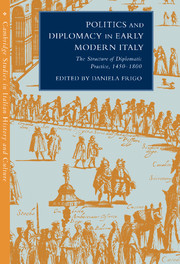Book contents
- Frontmatter
- Contents
- Introduction
- Diplomacy and government in the Italian city-states of the fifteenth century (Florence and Venice)
- Aspects of Medicean diplomacy in the sixteenth century
- An outline of Vatican diplomacy in the early modern age
- Economic and social aspects of the crisis of Venetian diplomacy in the seventeenth and eighteenth centuries
- ‘Small states’ and diplomacy: Mantua and Modena
- Neapolitan diplomacy in the eighteenth century: policy and the diplomatic apparatus
- Savoyard diplomacy in the eighteenth century (1684-1798)
- Index of names
- CAMBRIDGE STUDIES IN ITALIAN HISTORY AND CULTURE
Diplomacy and government in the Italian city-states of the fifteenth century (Florence and Venice)
Published online by Cambridge University Press: 29 October 2009
- Frontmatter
- Contents
- Introduction
- Diplomacy and government in the Italian city-states of the fifteenth century (Florence and Venice)
- Aspects of Medicean diplomacy in the sixteenth century
- An outline of Vatican diplomacy in the early modern age
- Economic and social aspects of the crisis of Venetian diplomacy in the seventeenth and eighteenth centuries
- ‘Small states’ and diplomacy: Mantua and Modena
- Neapolitan diplomacy in the eighteenth century: policy and the diplomatic apparatus
- Savoyard diplomacy in the eighteenth century (1684-1798)
- Index of names
- CAMBRIDGE STUDIES IN ITALIAN HISTORY AND CULTURE
Summary
This essay returns to and adapts a previous contribution of mine which provided the basis for several subsequent studies on the evolution of diplomacy in Italy (and particularly in Florence), on the advent of the regional state or – which is the same thing – of the oligarchical regimes. My experience of writing a commentary on the edited letters of Lorenzo il Magnifico, which confronted me with vast collections of late-fifteenth-century documentation, and which in particular familiarized me with Florentine diplomatic practice, has persuaded me of the outdatedness of the traditional approach to the study of Renaissance diplomacy, from the classic work by De Maulde la Clavière to the more recent book by Mattingly – both of which regard the resident ambassador as the key element in the transition from medieval to modern diplomacy, and as marking, in Italy first, the advent of the modern age. When writing on the conclusion of the Italian League (1455), Mattingly declared: ‘Italy first found the system of organizing interstate relationships which Europe later adopted.’ However, when considered from within, the reality is not so clear cut. To anticipate the argument developed later, and with my remarks restricted to Florence alone,prolonged embassies only became possible when Lorenzo had achieved full power as a result of the reforms of 1480, and they served as political bonds among regimes which provided each other with mutual support in potential situations of crisis (I refer to Florence's intercourse with Milan and Naples, and also with the Pope)
- Type
- Chapter
- Information
- Politics and Diplomacy in Early Modern ItalyThe Structure of Diplomatic Practice, 1450–1800, pp. 25 - 48Publisher: Cambridge University PressPrint publication year: 2000
- 4
- Cited by



